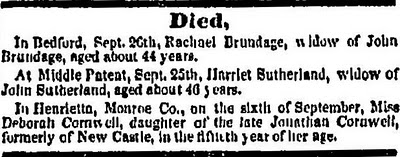When researching your family history, it can be very difficult to find information about women in the early 19th Century—finding genealogical resources that actually give women’s names and family details is challenging. It was common in the 19th Century for newspapers and government records to be brief and give only the basic information about a household in the census, or an entry in a birth register.From 1790 through 1840 the census only named one person from each household. This person was designated as the Head of the household. Most Americans—men and women alike—were simply not named in the early censuses.Birth and church registers often took the same approach as the census and only briefly recorded the facts of a birth.
A typical entry might be:
1812 July 28. A son, to Walter Hickenlooper.
What was the son’s or the mother’s name?
Because of these often-incomplete early records, genealogists have to dig deeper to find sources that give more information in order to fill in the missing details of our family trees. For the pre-1850 period newspapers are an import resource for that information, providing obituaries, birth and marriage notices, news reports, and other articles that provide stories and details about our ancestors’ lives often missing in government and church records.This Brundage obituary notice illustrates the point. It appeared in the Hudson River Chronicle which was published in Sing Sing, New York, on 8 October 1839. The obituary appeared on page 3.

The 1820 Census records a John Brundage living in Bedford, New York, with his wife (unnamed) and family.
However, in the 1840 census neither husband nor wife were listed. Why? The census provides no answers—but this obituary notice does. It tells us that John has previously died and that his widow (Rachael Brundage) died on 26 September 1839 at age “about 44 years”—well before the 1840 census.
From this short obituary notice we have gained two important clues:
· Clue #1. Name: Rachael Brundage, a widow of John Brundage; her age; her date and place of death
· Clue #2. Name of husband: John Brundage, and the fact that he had predeceased her
In addition to the details about Rachael and John Brundage, the article has two other obituary notices. Look at the facts that we find about these women: Harriet Sutherland and Deborah Cornwell.
Harriet Sutherland
The notice tells us that Harriet Sutherland died on 25 September 1839 at “Middle Patent” (North Castle, New York), the widow of John Sutherland. It gives her age as “aged about 46 years.” Two very helpful clues here:
· Clue #1. Name: Harriet Sutherland, a widow of John Sutherland; her age; her date and place of death
· Clue #2. Name of husband: John Sutherland, and the fact that he had predeceased her
Deborah Cornwell
And in the third obituary notice we learn that “Miss Deborah Cornwell, daughter of the late Jonathan Cornwell” died 6 September 1839 in Henrietta, Monroe County, New York, at the “fiftieth year of her age” and that she was “formerly of New Castle (New York).”
Two valuable clues:
· Clue #1. Name: Deborah Cornwell, a daughter of Jonathan Cornwell; her age; her date and place of death; that she formerly lived in New Castle, New York
· Clue #2. Name of father: Jonathan Cornwell, and the fact that he had predeceased her. It can be difficult to find a good woman in the early 19th Century—but newspapers are a terrific genealogical resource and GenealogyBank has more online newspapers than you will find anywhere else.

GenealogyBank is usually one of my first and most productive research stops! Newspapers are by far one of my favorite parts of research, since they yield so many interesting nuggets to further explore.